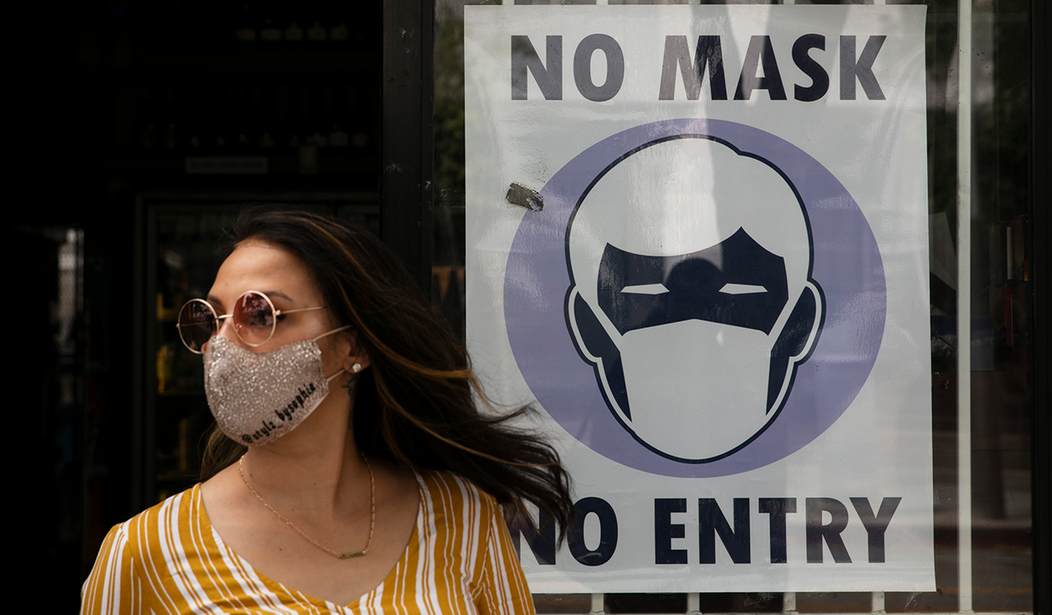Those who forget the failure of mask use during pandemics are bound to repeat it.
Yesterday on my blog, a commenter pointed out that we’ve had cloth for thousands of years. People have died of respiratory and infectious disease… well, as long as there have been people. Why have we never before hit upon a magical shield of cloth in front of face and nose to “stop” disease?
We could, of course, say that “our ancestors weren’t scientific” or that “we now know better.” But come on, that’s fan-dancing in front of the building on fire, and none of us is Jerry Nadler.
Our ancestors might not have had the germ theory or a precise understanding of how disease was passed on. However, they were practical people, by and large. Had to be, since they lived on the cutting edge between nature and civilization. They lost more babies to disease (and famine) than they reared and their healthy productive lives were maybe 20 years.
They very quickly, through experimentation, found out what worked and used it. Extensively. Which is why I smirk every time I come across a newly-written romance set in the regency in which the author preens on how bleeding was useless or bad for you. In fact, we’ve found, in a society without antibiotics, bleeding – though not to excess – could rally the body’s immune system to respond to infection.
A lot of things from bleeding to leeches to honey on wounds have been found to work. Our ancestors, it turns out, were not stupid. Only our presentism, from the safety of a society with near-magic antibiotics, allows us to sneer at them and imagine ourselves superior.
Their theories, from humors to the idea that disease was transmitted by bad smells, were all wrong. But the practice was right. It had to be. Their lives depended on it. If they hadn’t been smart about what worked (and didn’t) none of us would be here.
So, disease transmitted by sneezing/coughing… how come no one ever thought of tying a square of cloth in front of their nose/mouth?
The truth is that people – of course – thought of it. But outside limited circumstances such as health care workers (which I’ll explain in a minute), it’s not found to make much difference. And it causes problems with everyday living.
Starting with the black plague—which, as we all know (we all know it, right?), had a pneumonic form—people who had to be in contact with the patients found ways to try to protect themselves:

As you can tell, it was far more… protective, shall we say, than that bandana you tied over your face to get into Costco.
And yet, you know, people didn’t continue wearing it as they went forward after the plague (which recurred after the Great Death, by the way). Nor did common people wear it. Only those who must be exposed to the disease.
Yeah, yeah, we now think it was transmitted by fleas. (Actually there’s research being done all the time, and it’s possible we’re not even sure what the plague was. I mean, that’s a far-off theory, but…) However, it should at the very least have protected from the pneumonic (and more deadly) form and would, therefore, be worth wearing, right?
Yet somehow it dropped out of existence.
Myself, as we all know, am an out-of-the-past visitor, since tuberculosis is still endemic in Portugal (you have to have x-ays every matriculation to be allowed to attend school). In my parents’ day, it was epidemic. And yet, the government (which was national socialist and therefore intrusive) didn’t order everyone to tie handkerchiefs over their faces. This despite the fact that Portuguese live in far closer quarters than anyone here (particularly in those days, when my maternal grandparents raised five children in a one-room shack) and use public transportation. Oh, and this despite the fact that TB is transmitted by bacteria, which are much bigger than viruses and therefore more likely to be stopped by cloth.
Instead, the prohibitions were on being barefoot and spitting on the floor/ground when you cough. In other words, they were about close contact with other people’s secretions. (My corollary being “don’t cough in people’s faces and don’t French strangers.”)
But, you’ll say, that’s all from times and places that didn’t keep records, or do science very well.
Okay, then. So, let’s talk about the closest thing we have to this – though the mortality of Winnie-the-flu is nowhere near the same as that of the 1918 flu – the epidemic of 1918.
Masks for everyone, women, children (and cats?) were tried. They had no appreciable effect. [Note the comments on that blog about how coronavirus was going to decimate the Third World. It didn’t. It also failed to decimate the homeless. It is a nothingburger. The Y2K of viral infections.]
So, if they worked in 1920, why didn’t this pre-antibiotic world keep using them to deal with flus and colds?
Well, because they didn’t.
So, when the idiotic CDC and other idiots (like my governor) decided they liked the power over businesses and of forcing people to do irrational things, they tried to explain why what didn’t work in 1918 would TOTALLY work now. One of such articles is here:
Why Gauze Masks ‘Failed’ in 1918 — And What We Can Do Better.
Note the “failed” in dubious quotes, so you’re to understand that they really didn’t fail. No, your ancestors were just idiots and decided to stop wearing masks that were helpful with respiratory illnesses, even though, pandemic or not, respiratory diseases had a high butcher’s bill at the time.
The article is just as specious.
The first point (they say) on why masks failed is poor construction. But, they tell us:
Why we’ll do better 102 years later: All of us have access to cheaper, higher-quality fabrics than our ancestors did. We can also watch countless instructional YouTube videos and ask our social networks to double-check our work.
Oh, yeah. Your social networks would never steer you wrong. And higher-quality fabrics are fine and all, but you know, it’s not the quality, it’s how many layers of fabric, as one of my doctor-readers explains in a guest post (yes, it’s anonymous. He has a job):
My favorite source for data on mask composition (and it’s a good one – these are real benefits of proper mask wear and construction) is: https://pubs.acs.org/doi/10.1021/acsnano.0c03252. They report both filtration efficiency based on particle size, as well as the differential pressure drop. The pressure drop through the various mask materials doesn’t seem significant – 3.0 Pascals (Pa) for multilayer/hybrid cloth masks vs. 2.2 Pas for an N95 or 2.5 Pa for a surgical mask… until one realizes that (1) it represents 15-25% increase in resistance, and (2) the flow rate they tested – 1.2 cubic feet per minute (CFM) is around half of the normal RESTING breathing rate of a human (60 liters/min which equals roughly 2 cfm) whereas just WALKING typically results in flow rates up to 5x higher (300 liters/min). Now – there’s something important here – and that is that pressure drop increases with the square of flow rate (It’s called Bernoulli’s Principle). Fast walking, going up stairs, carrying a load (like an infant) means a 10x increase in airflow from what was tested. 0x airflow means 100x the pressure drop. So now the 3 Pa pressure drop for a cloth mask becomes 300 Pa drop. That may still seem insignificant compared to atmospheric pressure (100,000 Pa), but consider this – a standard CPAP setting of 10 = 1000 Pa – so the amount of pressure drop from a mask under these conditions is about one-third the pressure of a CPAP!
What this means is that there’s a trade-off and that any mask effective enough to actually slow down the virus would also put someone like me, with reduced lung capacity and reactive airways, into oxygen deficiency. Which is why no one wears the multilayer masks, not even in doctor’s offices, where they wear little paper masks I’d consider effective, MAYBE, for protecting me from dust while sanding.
They explain why shoddy masks give a sense of false security that causes people to stand really close, etc., but dismiss it with:
Why we’ll do better 102 years later: Although most of us will craft higher-quality masks today, we do need to take the social distancing warnings seriously. Taking extra risks will cancel out any positive benefits we reap from wearing a mask.
Which means he’s never been anywhere, including the grocery store. Or, of course, the happy, fun summer of love riots. Seriously?
The third reason given for why masks failed in 1918 is that people touched the masks constantly or moved them around. But, the article assures us:
Why we’ll do better 102 years later: Luckily, we have the benefit of a vast media culture that is prepared to show us the do’s and don’ts of mask etiquette.
I’m not giggling. Truly, I’m not. Seriously? The vast media culture will instruct us, and fortunately, 102 years later, we’re no longer apes who don’t like things touching and obstructing our faces. So, we won’t fiddle with them. I’ve yet to see ANYONE wearing the masks not continuously adjusting them, pulling them under their noses, etc. My favorite is beard-snood guys who wear their masks over their beards.
Another favorite was reported by a friend who saw a woman pull down her mask to sneeze. It makes perfect sense on the instinctive level. After all, you know, you don’t want to continue wearing something slimy and wet with your saliva, do you? The difference is that while this woman could probably have been trained to sneeze into her elbow or into her t-shirt and obstruct at least some of the particulates, the act of pulling down the mask didn’t give her time to cover the sneeze. So she sneezed over the entire vicinity.
But oh, yeah, the media will instruct us on what to do…. And we’ll obey, even though the media-induced panic over the virus is completely out of proportion with death rate, and we’re all so tired of intrusions into our daily lives.
Point four on why the masks failed, is that people wore them outside and in open spaces, and not in gatherings of intimates.
And this is why – snort, giggle – we’d do better 102 years later:
Why we’ll do better 102 years later: For those of us using face masks today, it is essential to learn which situations are the riskiest and prioritize wearing a mask during those times. For instance, public indoor locations, like the grocery store or a bus, will be riskier than the outdoors.
They’re not wrong about this, of course. Not on the times and locations where it might help. And many people of my acquaintance wear masks when meeting elderly relatives, or in other situations where they wish to protect others, though note that the single-layer bandanas over the face, etc., do nothing to protect anyone one way or another.
But they’re missing two very important things: Governments CAN’T legislate that you wear masks in personal, intimate, prolonged contact situations. And humans are still humans, with human needs that require contact and seeing the faces of other humans. They just do.
So governments legislate that we wear masks outside and in public. And, of course, we remove them as soon as we are inside and in prolonged contact.
By the way, for those of you wishing to say “doctors wear masks,” follow the link to my blog, where my guest poster explains it. Yes, they do. In situations where they aren’t moving much, and are IN PROLONGED CONTACT with the patient. And where masks are discarded between patients. Masks aren’t magic. If you wear them on that grocery store trip, you might get virus ON the mask. And then breathe it out over everything, for instance. Same with gloves, which actually prevent people washing hands as often as they should. Medical professionals change gloves constantly. And there’s a technique to putting them on.
This brings us to another thing: There is such a thing as viral or bacteriological load. It makes sense for health care professionals to protect themselves more because they are in contact with a lot of infected people, which increases the load they receive. Above a certain level, your immune system will have trouble fighting it off. This doesn’t apply to normal people, unless they are in contact with emissions from someone infected for a long period of time, etc.
However, the mask mandates that certain governors – like Colorado’s ever despicable Jared Polis – have imposed on their captive populations are not for dense masks. The masks aren’t – and in many cases, like mine, because I don’t wish to pass out – can’t be worn effectively. And they’re mandated in public spaces, even outdoors, where they aren’t needed.
It’s mask Kabuki theater all the way down, a demand of submission, in which you obey their irrational orders to be protected from a virus that’s not nearly as scary as they have tried to make you believe.
It’s all about the boot stamping on the human face.
World without end.









